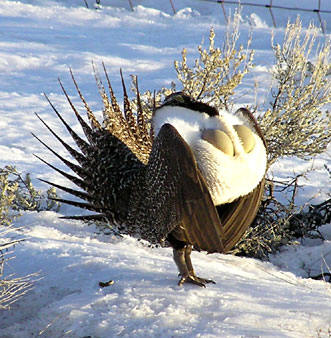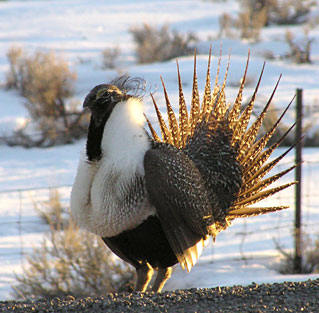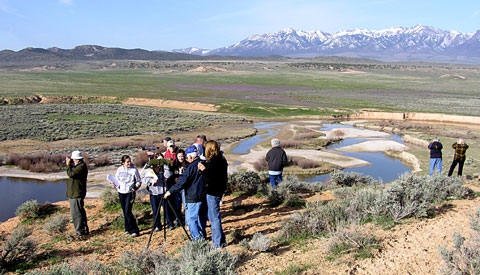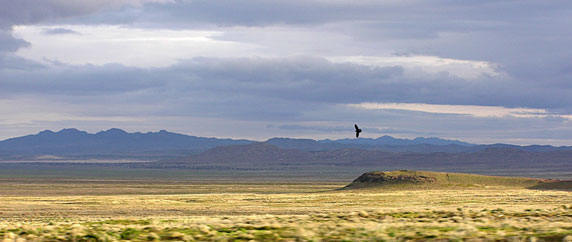Utah County Birders Newsletter
|
 |
|
Sage Grouse at Emma Park Lek (Carbon
County) -
|
 |
|
Sage Grouse at Emma Park Lek (Carbon
County) -
|
Field Trip Report
Carbon County Sage Grouse Trip - April 2, 2005
by Matt Williams
On Saturday, 2 April 2005, Utah County Birders headed southeast to the
tri-county (Utah, Carbon & Duchesne) area. Participants included Eric Huish
(trip leader), Tuula Rose, Reed Stone, Alton Thygerson, Bonnie Williams, Matthew
Williams plus 3 young ladies from BYU who were attempting to reach 75 species of
vertebrates. While it wasn’t the birdiest of trips, we had pretty good diversity
and helped the vertebrate total considerably.
We arrived at our destination shortly before the sun rose over Matts Summit in
Carbon County. Only a few Sage Grouse were initially visible but with the
combination of the waxing light and our increasing ability to pick out birds
from snowy sagebrush sea, we soon found many. The fact that the birds seemed to
be congregating on the road and its edges certainly didn’t hurt either. The
males displayed without any regard for the two silver SUVs packed full of
birders or for the occasional car that whizzed right by them. At this location
there were anywhere from 40-60 birds. It was a fantastic sight to see these
beautiful birds lit by the golden morning sunshine. We left the lek and
continued to see Sage Grouse (probably another 30 or more) on our way back east
to Route 6. Much to the delight of certain county listers present, we even saw
several Sage Grouse within Utah County. The bulk of the lek was in Carbon.
While stopping to check out what ended up to be a Robin lit up atop a bare
branch, we found some Mallards and Cinnamon Teal in the river just off of Route
6. Mountain Bluebirds lined our route along the edge of a very frozen Schofield
Reservoir. Just before we had completely given up hope for any waterfowl, we
spotted a crack in the ice where there was open water and ducks. After an
unsuccessful restroom and grosbeak search in the town of Schofield, we got back
to the lake. Two beautiful and close Sandhill Cranes greeted us and each other
with a wonderful dance display. The male (presumably) grabbed bits of vegetation
in his bill and tossed them as he hopped, skipped and did just about anything he
could to win the favor of his companion.
The waterfowl flock was certainly not large but for the fewer than 100 birds
present, the diversity was fairly high. A handful of Ring-necked Ducks turned
out to be hiding a Lesser Scaup in their midst. Canada Geese and Common
Mergansers were mostly just standing around the open patch. Several Bufflehead
and a couple Common Goldeneye dove almost constantly. Our trip leader picked out
2 nice American Wigeon that were resting alongside Mallards, Gadwall and
Cinnamon Teal. Here, we also heard a Northern Flicker and a singing Western
Meadowlark.
Fortunately for all, an open restroom was found at one of the parking/picnic
areas. Nearby, a beaver pond contained several more Common Goldeneye. A small
spillway just off the road contained 3 Green-winged Teal. Conversation along the
way back led us on a small detour up the road to Sheep Creek Canyon, where we
thought we might try for Blue Grouse. After a few sightings of deer to help the
vertebrate listers, the road got snowy so we decided that it may have been a bit
early for Blue Grouse. On the way back down towards the valley, we saw a Golden
Eagle soaring and a Bald Eagle along the river.
We ended the day at Evergreen Cemetery in Springville. This spot gave us the
best chance at a few new species. The first one was Juniper Titmouse and after
that, many of us got distracted. Eric tracked down and got us looking at a few
Pine Siskins that had flown into a nearby tree. While looking up, we spotted a
Turkey Vulture, which was a year first for several people. Then, when we thought
we’d find no more, we added Red-breasted Nuthatch, Brown Creeper and
Ruby-crowned Kinglet for a lively end to a great day of birding.
------------------------------------------------------
 |
|
Utah County Birders near Yuba Dam - April 16, 2005 photo by Eric Huish |
Field Trip Report
Sanpete County Tour - April 16, 2005
by Leena Rogers
Saturday, April 16, turned out to be an excellent day of
birding for nine Utah County Birders and six BYU students. We set out from the
Sam’s Club Parking lot in south Provo on a beautiful but very chilly morning for
Sanpete County. Our first stop was along I-15 at Juba Reservoir, then
back up to Hwy 28 with a stop at Chicken Creek Reservoir. From there we
continued south on Hwy 28 to Painted Rock State Park on the southeast
shore of Juba Reservoir [not marked on all maps]. There seemed to be almost as
many people as birds out on the reservoirs ,and the insects [thankfully the
non-biting kind] were out in full force too. A sure sign that spring is here! We
then drove up Hwy 89 to
Nine Mile Reservoir, made a quick stop at the wetlands near Fayette,
then on to Palisades Park by Sterling. Our final stop of the day was
along Hwy 132 at Wales Reservoir near Moroni.
It was great to have the students with us. The enthusiasm they showed each time
a new bird was spotted gave the rest of us seasoned veterans an opportunity to
see our feathered friends
through “fresh eyes.” The kids had Saturday finals and left the group early but
the rest of us continued on until mid-afternoon. A magnificent Golden Eagle
perched on top of a roadside telephone pole near Wales Reservoir capped off a
great day of birding! Grand total of birds seen by the group was 75. Trip leader
was Tuula Rose. Following is a list of the highlights at each stop:
Juba Reservoir
Loggerhead Shrike, Red-tailed Hawk, Rock Wren, Tree Swallow, Cliff Swallow,
Black-necked Stilt, American Robin, Northern Shoveler, Northern Pintail, Canada
Goose, Belted Kingfisher, Northern Shrike, Eared Grebe, Green-winged Teal,
Kildeer, Red-winged Blackbird, Western Meadowlark, House Sparrow, Gadwall,
Brewer’s Blackbird ,House Finch, European Starling, Brown-headed Cowbird,
Dark-eyed Junco, White-crowned Sparrow, Common Raven, American Coot, Cinnamon
Teal, Mallard.
Chicken Creek Reservoir
Lesser Scaup, Say’s Phoebe, Redhead, Willet, American Avocet, Barn Swallow,
Rough-winged Swallow, Sage Thrasher, Long-billed Curlew, Yellow-headed
Blackbird, Snowy Egret, Bufflehead, California Gull, White-faced Ibis,
Franklin’s Gull ,Violet-green Swallow, Western Kingbird, Horned Lark.
Painted Rock State Park
Western Grebe, Clark’s Grebe.
Fayette Wetlands
Double-crested Cormorant, White-faced Ibis, Turkey Vulture, Sandhill Crane,
Northern Harrier, Swainson’s Hawk, Osprey.
Nine Mile Reservoir
Canvasback, Common Loon, Ring-necked Duck, Common Merganser, Vesper Sparrow,
Red-breasted Merganser, Yellow-rumped Warbler (Audubon), Black-billed Magpie,
Rock Pigeon.
Palisades State Park
Canyon Wren [great looks up close], Yellow-rumped Warbler [Myrtle race],
American Goldfinch.
Along the Way
Mountain Bluebird, Mourning Dove, Kestrel, Lark Sparrow.
Wales Reservoir
American Wigeon, Ruddy Duck, Golden Eagle.
Thanks Tuula for arranging such a successful birding trip, and thanks to those
who were willing to drive. Happy spring birding everyone.
------------------------------------------------------
 |
|
Cloudy weather made for beautiful scenery on our way out
to Fish Springs |
Field Trip Report
Fish Springs - April 30, 2005
by Tuula Rose
The weather gods were good to our group of eight venturing to the West Desert for a long drive on the historic Pony Express route to Fish Springs. The road gods also had heard our prayers and the drive was not half as bad as we had feared. Several sightings of beautiful Pronghorn Antelope delighted us on the way. A brief stop at Simpson Springs yielded the first Lark Sparrows. The campground was full of tents and the smells of frying bacon reminded us of the missed breakfast due to our early start. The best birds en route were a Prairie Falcon (a lifer for Matt) perched on a rock, a Short-eared Owl flying low over the grasses and several Long-billed Curlews.
Soon after entering the Wildlife Management Area we came to the first ponds and wetlands where we quickly doubled the trip list of fifteen species found on the way. Several duck species including a Canvasback and a very festive blue-billed Ruddy Duck plus a Red-breasted Merganser were in the pond and several Common Yellowthroat were heard, and after a little chase also seen in the reeds. A female Northern Harrier treated us to a spectacular aerial show that appeared downright reckless in its plunging dives and upside-down loops.
We were hoping to find a few more migrating warbler species besides Yellow and Yellow-rumped in the trees by the Park Headquarters, but were probably a week or two early for the main migration. The auto tour through the marshes gave us looks at most of the larger waders including Ibis, Avocets, Stilts, Willets, and Long-billed Dowitchers. Black-crowned Night Herons and Snowy Egrets were everywhere. We were lamenting the absence of smaller sandpipers when someone yelled "shorebirds flying" and a good-sized flock landed within scoping distance. No peeps, but a flock of beautiful breeding-plumaged Red-necked Phalaropes. Our target species, the ever elusive American Bittern lived up to its reputation. All the numerous night-herons flushing all over the place also refused to turn into bitterns while the real ones refused to flush, only turning up their noses at us, invisible, blending in the reeds.
According to the updated and fabulous Wildlife Checklist the bittern is common all year round at Fish Springs. This list is the best I have ever seen at any Wildlife Refuge. Kudos to Colby Newman et. al. for good work. The list has information on 272 species of birds seen on the refuge. Our group saw a total of 63 species on our trip, the last being a Black-throated Sparrow found singing on the sage-brush hillside on the west side of the Refuge. A memorable day!
The Desperate Northern Flicker.
by Reed Stone
Today’s date is April 24, 2005. For about two months my wife and I have watched
the NORTHERN FLICKER patiently and laboriously chiseling, chipping and carving a
nesting cavity in a dead cottonwood tree. The tree is about 50 ft. from our bay
window where we have a clear view of the activity. The work is going on the
shady side of the trunk.
When the hole became deep enough for "Woody" to get half way in the STARLINGS
began monitoring the site. As Woody continued chiseling deeper and deeper the
STARLINGS increased their attention. When Woody would leave, even for a moment
the robber STARLINGS would enter the cavity. When Woody would return and find
the robber inside he would reach in and grab the robber by the head and
literally drag it out by the head. They would then lock "talons" and flutter
almost to the ground, a fall of about 20 ft. This happened many times though it
was not always the full distance.
The aggressiveness is beyond my ability to describe. With the WOODPECKER
literally standing on his head chiseling and chipping a starling would enter the
cavity, going over the back of the WOODPECKER, with its beak full of nesting
material and attempt to take over. I am sorry to report that it often
successfully repulsed and flushed the WOODPECKER from the cavity it had so
laboriously evacuated.
As the labor continued the STARLINGS, sometimes as many as six, would perch
intimidatingly close, just waiting for a chance to take over. Once the cavity
was deep enough for the STARLINGS to use, they would come by twos carrying
nesting material. With two STARLINGS in the cavity they would repulse Woody from
reclaiming his hard-earned nest cavity.
Woody would go around the neighborhood drumming out his territory. He would drum
mostly on our aluminum chimney cap rattling our whole house. I agreed with my
wife, he had earned the right. At first the drumming was a little annoying.
After observing the great effort of Woody trying to protect his nesting cavity
the drumming became music to our ears.
Finally with the continual effort of trying to maintain some control of his
domain and drumming for a mate she arrived. She accepted the nesting place. With
her in the cavity and Woody on the outside they had some degree of ownership.
The starlings still maintained their presence and intimidating attitude as the
woodpeckers threw out the nesting material.
Like thieves on one’s doorstep the woodpeckers could not leave without the
interlopers taking over. Sometimes there were as many as six starlings mobbing
the site.
For several days the pair of WOODPECKERS were able to keep the STARLINGS at bay.
However, with the continuing pressure, the WOODPECKERS were driven from their
hard earned nesting cavity.
There may possibly be a bright side to the story because the male WOODPECKER
still drums and calls out his territory. It is just possible he has another
nesting site; I sincerely hope so.
My conclusion. It is an absolute wonder to me that any cavity nesting bird is
not at great risk of being eliminated by the aggressive starling. I refuse to
capitalize starling again. There needs to be concerted effort to reduce their
numbers and give cavity nesters a chance.
If you have a random observation you would like to share please send it to newsletter@utahbirds.org.
Backyard Bird of the
Month
April 2005
Steve Carr - Holladay
Mallard - A pair walking around the backyard, close to Mt. Olympus.
KC Childs - Orem
Cassin’s Finch
Wade Covert - Provo
Cassin's Finch - welcome addition to my birdseed welfare program.
Sylvia Cundick - Provo
Lazuli Bunting - 26 on April 24th.
Alona Huffaker - Springville
The Lazuli’s are back and sooooo gorgeous!
Eric Huish - Pleasant Grove
Plumbeus Vireo - New for yard, species #84
Milt Moody - Provo
Green-tailed Towhee - Bright rusty cap and losts of green
Cheryl Peterson - Provo
25+ Cassin's Finches - new for yard
Bruce Robinson - West Jordan
Cedar Waxwing - 12 in a tree, new yardbird
Tuula Rose - Provo
Bullocks Oriole - Two males, sipping hummingbird nectar on opposite sides
of the feeder
Bonnie Williams - Mapleton
Lincoln’s Sparrow - New for my yard.
We would like
you to share your favorite backyard bird each month. Please send your favorite
bird at the end of the month to newsletter@utahbirds.org or call 360-8777. If
you would like a reminder at the end of the month e-mail the above address.